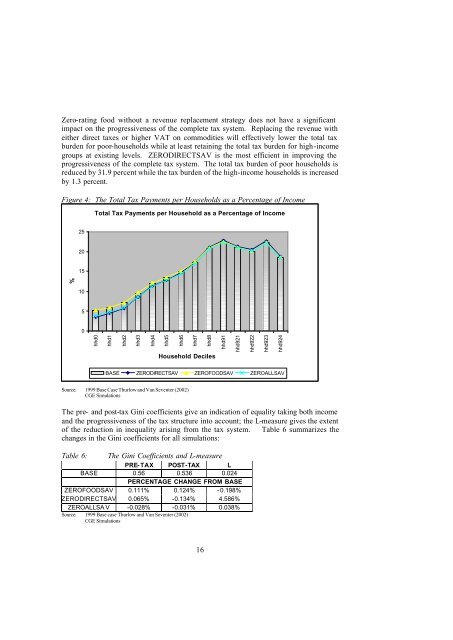Marna Kearney - tips
Marna Kearney - tips
Marna Kearney - tips
You also want an ePaper? Increase the reach of your titles
YUMPU automatically turns print PDFs into web optimized ePapers that Google loves.
Zero-rating food without a revenue replacement strategy does not have a significantimpact on the progressiveness of the complete tax system. Replacing the revenue witheither direct taxes or higher VAT on commodities will effectively lower the total taxburden for poor-households while at least retaining the total tax burden for high-incomegroups at existing levels. ZERODIRECTSAV is the most efficient in improving theprogressiveness of the complete tax system. The total tax burden of poor households isreduced by 31.9 percent while the tax burden of the high-income households is increasedby 1.3 percent.Figure 4: The Total Tax Payments per Households as a Percentage of IncomeTotal Tax Payments per Household as a Percentage of Income2520151050hhd0hhd1hhd2hhd3hhd4hhd5hhd6hhd7hhd8hhd91hhd921%Household Decileshhd922hhd923hhd924BASE ZERODIRECTSAV ZEROFOODSAV ZEROALLSAVSource: 1999 Base Case Thurlow and Van Seventer (2002)CGE SimulationsThe pre- and post-tax Gini coefficients give an indication of equality taking both incomeand the progressiveness of the tax structure into account; the L-measure gives the extentof the reduction in inequality arising from the tax system. Table 6 summarizes thechanges in the Gini coefficients for all simulations:Table 6: The Gini Coefficients and L-measurePRE-TAX POST-TAX LBASE 0.56 0.536 0.024PERCENTAGE CHANGE FROM BASEZEROFOODSAV 0.111% 0.124% -0.198%ZERODIRECTSAV 0.065% -0.134% 4.586%ZEROALLSA V -0.028% -0.031% 0.038%Source: 1999 Base case Thurlow and Van Seventer (2002)CGE Simulations16
















